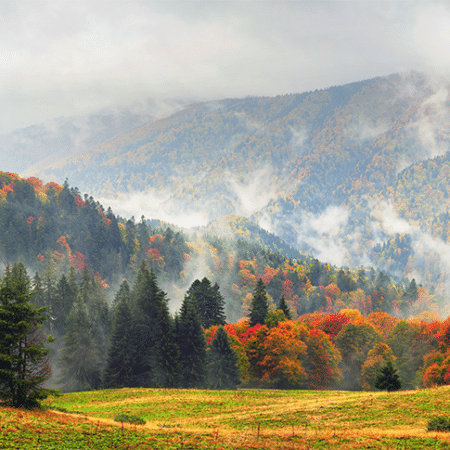CONSIDER THE SMOKY MOUNTAINS FOR YOUR NEXT GREAT ADVENTURE!
Along the border between North Carolina and Tennessee lies ridge upon ridge of forest known as the Great Smoky Mountains National Park. It is America’s most visited national park simply for the beauty of its ancient mountains, diversity of plant and animal life, and the remnants of Southern Appalachian mountain culture. Whether you delight in the challenge of mountain hiking or prefer to sit quietly before panoramic vistas, the Smoky Mountains offer activities for everyone to enjoy. The hardest part may be choosing which trail, waterfall, overlook, or historic area to explore!
The mountains themselves are among the oldest in the world, formed perhaps 200-300 million years ago, and they have a long human history, as well, spanning thousands of years from the prehistoric Paleo Indians to early European settlement in the 1800s and the loggers of the 20th century. When the first white settlers reached the Great Smoky Mountains in the late 1700s they found themselves in the land of the Cherokee Indians, one of the most culturally advanced tribes on the continent. After the forcible removal of most of the Cherokee to Oklahoma, along what is known as the Trail of Tears, the mountain people sustained their lifestyle by hunting the wildlife, utilizing timber for buildings and fences, growing food, and pasturing livestock in the clearings. As the decades passed, many areas that had once been forest became fields and pastures, and the people created rural communities where they attended church, engaged in farming and commerce, and maintained community ties. Within the current Great Smoky Mountains, National Park there remain ninety-seven historic structures, including grist mills, churches, schools, barns, and the homes of early settlers, which preserve the Southern Appalachian mountain heritage of the region.
Most visitors come to the Smoky Mountains hoping to see a bear since approximately 1,500 bears live within the park itself. But there is much more to the Smokies than just large animals like bear, deer, and elk. The park is a sanctuary for a magnificent array of animal and plant life, and it has the most biological diversity of any area in the world’s temperate zone. For instance, there are tens of thousands of plant species in the region, including an astonishing display of colorful trees and wildflowers, and there are at least 30 different species of salamanders in the National Park alone, which is the most diverse salamander population anywhere in the world. This distinction has actually earned the park the nickname “Salamander Capital of the World.”
Though the Smokies are beautiful at any time of year, it is important to keep in mind that temperatures can vary 10-20 degrees from mountain base to the mountaintop, and clear skies at lower elevations do not guarantee equally pleasant weather on the higher peaks. But it is this diversity that creates such a unique environment for visitors. Due to ample rainfall and the elevation gradient, waterfalls can be found on nearly every stream in the park, and the wispy, smoke-like fog that hangs over the mountains and gives them their name actually comes from the rain and evaporation from the trees.
These ancient Smoky Mountains still contain many mysteries and wonders, and the 800 square miles of Great Smoky Mountains National Park offers enormous opportunities for exploration and discovery. During the past year, Joshua Expeditions has been privileged to take students to these majestic mountains, as well as visit the city of Gatlinburg and spend time in the Ocoee Region of Tennessee on whitewater rafting adventures. This Smoky Mountains Retreat is a perfect tour for adventurists and intellectuals alike, and we are pleased to be offering the tour again in 2011-2012. Take a look at a sample itinerary today and then contact us to help plan your Smoky Mountain Adventure!



